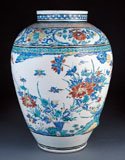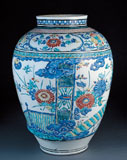- Museum Accession No.: EA2000.19
- Catalogue No.: 191
- Object type: Jar
- Kiln/Location: Kakiemon, Arita
- Period/Date: c. 1670
- Dimensions: H. 42 cm, Red seal fuku mark
- Provenance: Anonymous gift
- Description: Large baluster jar. Overglaze enamels in the Kakiemon palette. Decoration of a fence and a veranda divided by a vertical formal wide motif, with clouds in blue. The main decoration of sprays of flowers includes peonies and chrysanthemums springing from rockwork and rudimentary banded hedges and flying insects. The shoulder with a main border of shaped cartouches of chrysanthemums divided by formal floral motifs, with subsidiary borders including a band of lappets) the neck with squared motifs. The lower part with a wide plain border and three black circumferential rings. The underside of the foot with a broad green enamel circumferential ring and a red square fuku mark.
Slightly misshaped in the kiln, where the lower body has sagged, the jar nevertheless stands upright. This sagging has been exploited by the decorator, rather than concealed, by the placing of a major part of the enamelled decoration just at this place. This is a very large jar for the period (see also no. 190, which is some 7 cm shorter), and the kiln-master evidently decided not to destroy it on account of the sagging, but that given the technical difficulty (and expense) of making such a jar, it was to be decorated with exceptionally fine enamels by a highly-skilled and imaginative enameller. The only comparable vessels of this size and of approximately this style of decoration are the trumpet vases at Hampton Court (see Porcelain for Palaces, 1990, no. 137), which are 47 cm tall, where the painting is neater and less virtuoso. The jar would have stood some 10 cm taller with its lid. The jar, no. 190, and the similar Victoria and Albert example (Porcelain for Palaces, 1990, no. 93) and the comparable jars at Kassel (Kassel, 1990, nos. 208, 209) are in quite another style of decoration, as are the even larger jar in the British Museum (Jenyns, 1965, pl. 50), which may be earlier, and the facetted jar in the Idemitsu Museum (Idemitsu, 1990, no. 520), which may be later. The painting of the fence and veranda, as well as the upright dividing motif descend directly from those found on Early Enamel jars such as no. 50, of the 'Dark blue and dark yellow group', themselves ultimately derived from Yamato-e painting. The style of painting is also akin to the same type of jar, but in this new palette of enamels, and is unusually free for a large piece. The handling of the clouds, the rockwork and the rudimentary banded hedges, as well as the great sweep of the flower sprays is exceptional. The cartouches on the shoulders look forward to the later Kakiemon. It seems more than probable that there is a direct link between the Early Enamelled type and this jar - perhaps the same workers using a new palette. The enamel ring around the inside of the foot is unexpected; perhaps the jar stood on a chatsu (ring) stand in the kiln rather than on the base alone; this would have been unglazed and enamelled later. It is also unprecedented for such a jar to have a mark. The overglaze red seal-character mark reads fuku, 'good luck'.
Published: Nippon toji taikei, 20, 1997, no.30
- Exhibited: Porcelain Park, 1993, no.16
- Similar Example:
- Illustrated:
|
Main View
|




